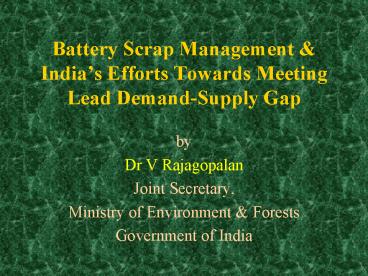Battery Scrap Management - PowerPoint PPT Presentation
1 / 24
Title:
Battery Scrap Management
Description:
Role of Secondary Production in Rest of the World. Role of ... HZL to add 35,000 MT by 2003-2004. BIL to add 25,000 MT by 2002-2003. Italian technical know-how ... – PowerPoint PPT presentation
Number of Views:197
Avg rating:3.0/5.0
Title: Battery Scrap Management
1
Battery Scrap Management Indias Efforts
Towards Meeting Lead Demand-Supply Gap
- by
- Dr V Rajagopalan
- Joint Secretary,
- Ministry of Environment Forests
- Government of India
2
Global Lead Mine Production
3
Production of Lead in India
4
Decline in Lead Production
5
Role of Secondary Production in Rest of the World
6
Role of Secondary Production in India
7
Estimated and Actual Demand of Lead - 1997-98 to
2000-01 (9th Plan)
8
Growth of Actual Demand for Lead
9
Rate of Growth of Lead Consumption during
1997-2000
10
Projected Damand - Supply Gap
11
Lead Demand for Automobile Batteries
12
Estimating Total Lead Demand
13
Salient features of Batteries legislation
- Consumers to return used batteries and
manufacturers / assemblers / reconditioners /
importers responsible for collection of batteries
and transport to registered recyclers. - Auction of used batteries only in favour of
registered recyclers - Dealers are also responsible for collection.
- Level playing field
- Collection of batteries 50 in the first year,
75 in the second year and 90 from the third
year onwards. - Batteries have been categorised.
14
Registration Scheme
- Covers used acid batteries, zinc waste, waste oil
- Started in 1999 35 units registered for LAB
- Facility inspection mandatory
- Compliance with regulatory standards
- Secured landfill with leachate collection system
- ESM code of practice laid down
- Indian approach broadly on the lives proposed by
GETF - individual facility based
- waste specific
- mandatory compliance with national standards
- ESM compliance built into national legislation
through mandatory registration of recyclers - List of registered recyclers displayed on web
site - transparency
15
ESM code of Practice on Air Pollution Control
16
What Attracts Dealer to the Trader
17
Cost Advantages of Re-Conditioner
18
Flow of Battery Scrap - Prior to Batteries
Legislation
19
Battery Scrap Flow with 50 Collection
20
Battery Scrap Flow with 75 Collection
21
Battery Scrap Flow with 90 Collection
22
Impact of Batteries legislation on demand-supply
- Role of traders would diminish / vanish
- Increase in supply - year 1
- increase in supply - year 2
- increase in supply - year 3
- Secondary smelting viable - addl. Capacities
planned - HZL to add 35,000 MT by 2003-2004
- BIL to add 25,000 MT by 2002-2003
- Italian technical know-how
- Availability of battery scrap - critical for
future additions - Enforcement holds the key
23
Impact on Demand Supply (contd.)
- Demand and supply - informal sector ignored
- Bridging demand - supply gap
- Expand primary production-ore reserves limited
- Expand secondary production
- HZL to add 35,000 MT by 2003-2004
- BIL to add 25,000 MT by 2002-2003
- Italian technical know-how
- GETF approach to implement ESM in Basel
Convention requires serious consideration - Using the ISO system recognised in WTO
- facility specific, waste specific
- mandatory compliance with national standards
- transparency
24
Thanks































